
https://www.newbridgehouseandfarm.com
Newbridge House is a Georgian Villa built to the design of James Gibbs in 1737 for Charles Cobbe (1686-1765), Archbishop of Dublin. For many years, it was attributed to Richard Castle, but in 2000 a plan for Newbridge was discovered which suggests it was the work of James Gibbs, an English architect. [1] As Alec Cobbe and Terry Friedman highlight in their 2005 study, James Gibbs in Ireland: His villa for Charles Cobbe Archbishop of Dublin: “Newbridge, in its simplicity and beautiful proportions, stands as a handsome achievement of Palladian restraint, one of the very few of Gibbs’ country houses to survive largely unaltered.”
In Great Irish Houses, with forewards by Desmond FitzGerald and Desmond Guinness, we are told:
“The Cobbe family association with Newbridge stretches back to the late mid 18C when Charles Cobbe was named Archbishop of Dublin, a prestigious and lucrative title with a salary of up to £10,000 per annum. The Archbishop immediately began to think of living quarters in line with his station and turned to Newbridge where a medium-sized Stuart house already existed. In engaging Gibbs for the rebuilt, Cobbe and Friedman note the Archbishop took “a step distinctly independent of what was happening on the architectural scene in Dublin.” A grand architectural design for Newbridge was abandoned when the Archbishop failed to secure the See of Armagh and Gibbs set about rescaling the design to one more closely resembling the property that stands today.” [1]
Charles Cobbe advanced rapidly through the ecclesiastical ranks; he was appointed Dean of Ardagh in 1718, Bishop of Killala in 1720, Bishop of Dromore in 1727, Bishop of Kildare in 1732, and finally Archbishop of Dublin in 1746. He married Dorothea, daughter of the Richard Levinge 1st Baronet, Speaker of the House of Commons, and Chief Justice of Common Pleas in Ireland, of Knockdrin Castle, County Westmeath. She was the widow of John Rawdon 3rd Baronet, of Moira House, County Down.
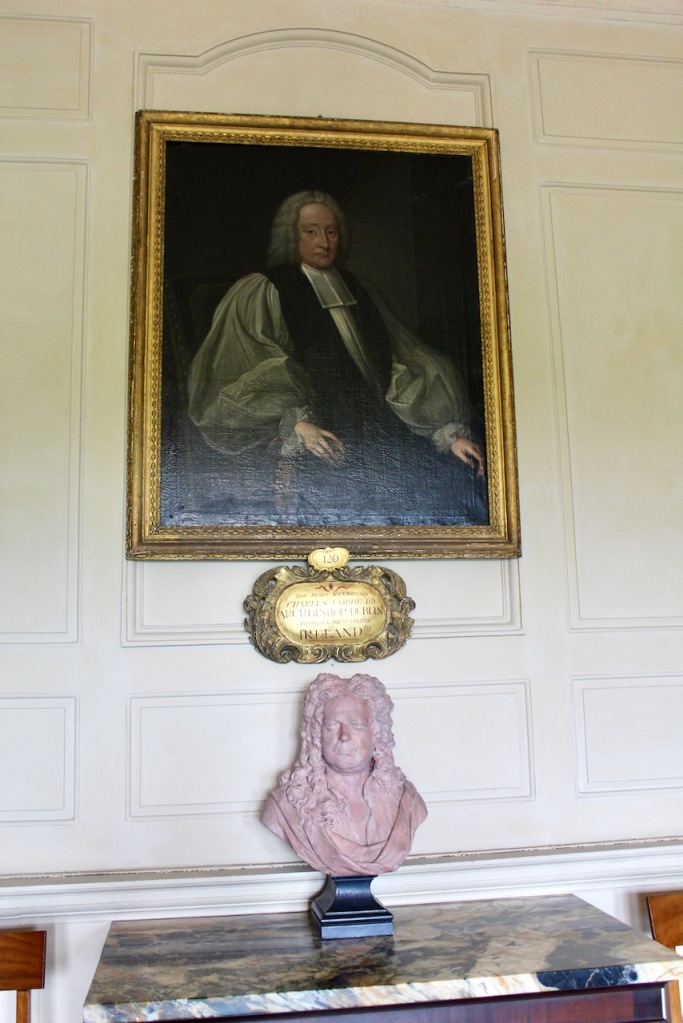
Mark Bence-Jones describes Newbridge House in his A Guide to Irish Country Houses (1988):
“Of two storeys over high basement, ashlar faced entrance of six bays, with a pedimented tripartite doorcase. Broad flight of stairs with ironwork railings up to hall door; shouldered window architraves; solid roof parapet with urns and eagles at corners.“

The website for Newbridge House tells us: “In 1985 the family gave the house and sold the demesne to Dublin County Council (now Fingal County Council) entering into an agreement under which the historic family-owned pictures, furniture and documents, are kept in situ while the Cobbe family remains in residence. As a result of this agreement, the interiors of Newbridge House are remarkably complete and amongst the best preserved in Ireland.“
Dublin county Council began an extensive programme of restoration, renovation and reconstruction when it took over ownership of the house. The house was opened to the public in 1986 along with 360 acres of landscape which had been developed in the style of the English landscape movement, probably to the designs of Charles Frizell from Wexford [2]. Additions include the cobbled courtyard designed by Robert Mack and built about 1790. This too has been extensively restored and now houses a museum on late 18th century rural life.
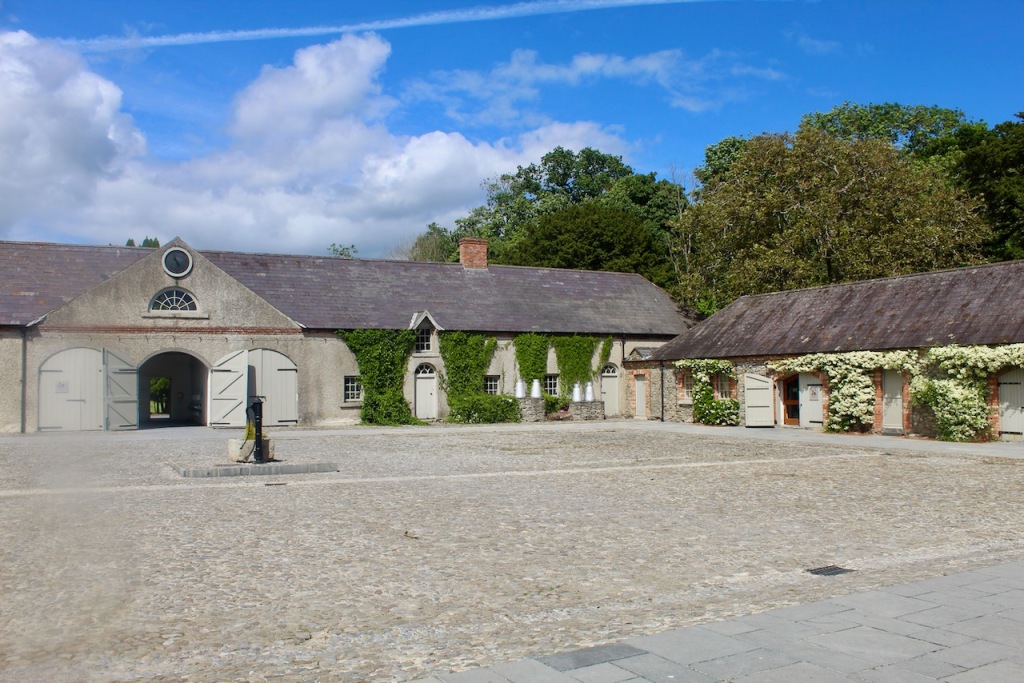
Hugh Montgomery-Massingberd and Christopher Simon Sykes describe the acquisition of Newbridge House in their Great Houses of Ireland: “the enterprising pair of Michael Lynch, of Dublin County Council’s Parks Dept, and Matt McNulty, of Bord Failte (the Irish Tourist Board), who had already rescued the historic Malahide Castle nearby to be a tourist attraction, stepped in with an ingenious solution [in 1985]. The Cobbes could continue to reside in the house in return for leaving most of the contents – the original Irish furniture, pictures and works of art on display – in situ on loan.” [3]
In 1749 three years after Charles Cobbe was made Archbishop of Dublin, he hired his friend, architect George Semple, to add the 100 foot spire to St Patrick’s Cathedral in Dublin. Before this, Jonathan Swift, a former Dean of St. Patrick’s had objected to a steeple.
The website tells us about the history of the Cobbe family:
“In 1717, Charles Cobbe (1686-1765) came to Ireland as private secretary and chaplain to his kinsman Charles Paulet, 2nd Duke of Bolton and Lord Lieutenant of Ireland. He was appointed Bishop of Killala in 1720 and his career progressed with successive bishoprics until he was enthroned as Archbishop of Dublin in 1743.
“Cobbe began purchasing lands on the Donabate peninsula in 1736, and commissioned the celebrated architect James Gibbs in 1744 to design a plan for the rebuilding of Newbridge House, where a house had stood previously. Work began in 1747 and Newbridge is Gibbs’s only executed work in Ireland.
“The Archbishop gave the near-finished building to his only surviving son, Thomas (1733-1814) in 1755, on the latter’s marriage to Lady Elizabeth (Betty) Beresford, youngest daughter of the 1st Earl of Tyrone [of Curraghmore, County Waterford]. By extending the house, decorating it with ornamental stucco, collecting pictures, porcelain and commissioning furniture from Irish cabinetmakers, Thomas and Lady Betty left a significant mark on Newbridge which is still evident today.”
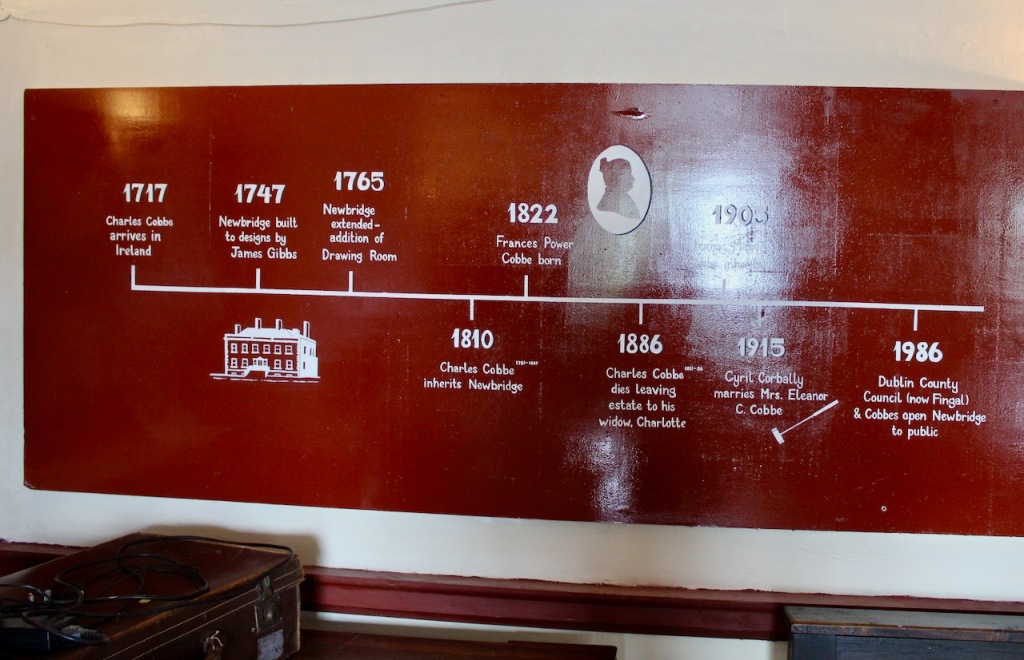
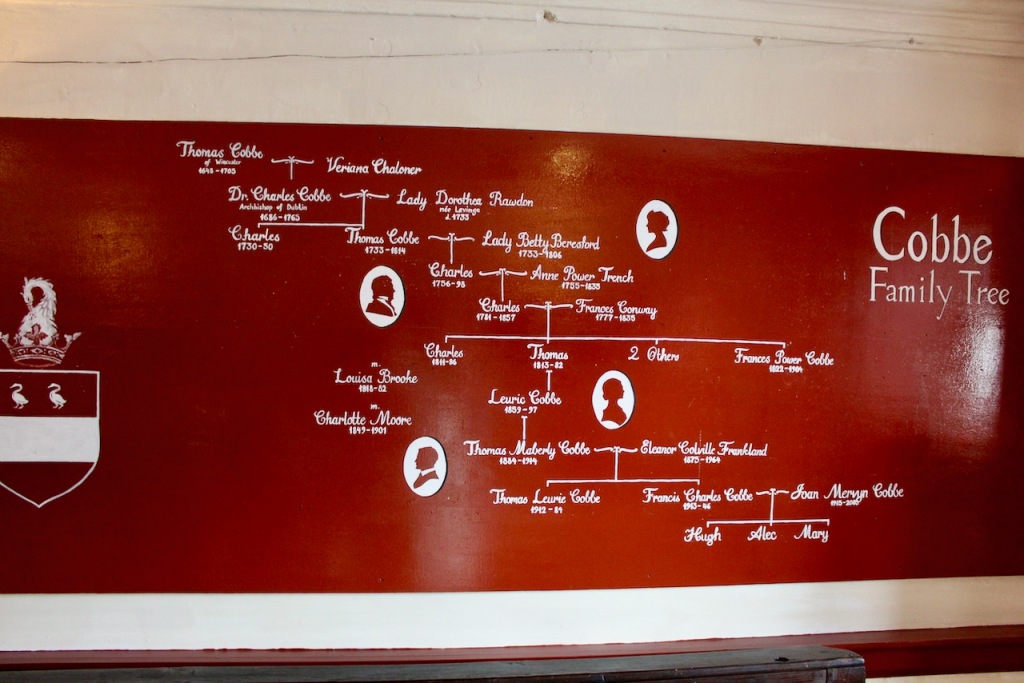

The entrance hall, which is one of the three halls, has a grand a pedimented chimneypiece flanked by doors that have shouldered architraves. The coat of arms of the Cobbe family features two swans with the legend Moriens Cano (dying, I sing), along with the Archbishop’s coat of arms. The plaster cornice features an oak leaf and ribbon frieze, and the chair rails and skirting all have the mark of Gibbs as seen in other houses of the period. The flooring is of Portland stone and Welsh slate. Throughout the house, the plasterwork is attributed to the Dublin stuccodore Richard Williams, who is documented as receiving payments at Newbridge during the early 1760s. [4]
Off the entrance hall is a study, where locals remember doing business across the large desk in the centre of the room, selling hay or buying cattle. Family portraits hang on the walls and there is a writing desk that was used by a daughter of the house, Frances Power Cobbe, the great social campaigner. Her two autobiographies provide a telling insight into the 19th century operation of the house. [see 4]
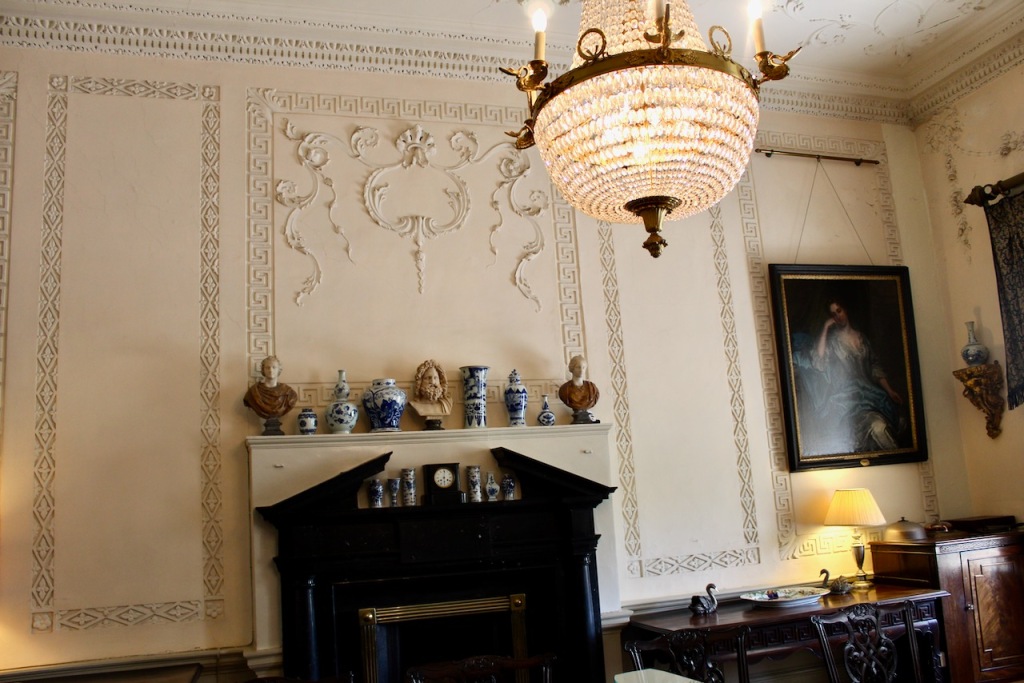

To the right, facing south, is the dining room, which features a black Kilkenny marble broken-pedimented chimneypiece. It is likely that this followed a Gibbs design, as drawings for similar pieces exist for the drawing room, library and saloon at Kelmarsh Hall, Gibbs’ Palladian-style mansion in Northampton [see 1]. Both the walls and ceiling are decorated with ornate stuccowork, with the Greek key motif of the panel frets replicated in the side tables made for the room. A hand-operated dumb-waiter sits in one corner. The room has a portrait of the Duke of Bolton as Knight of the Garter and a portrait of the Archbishop. [see 4, p. 243]
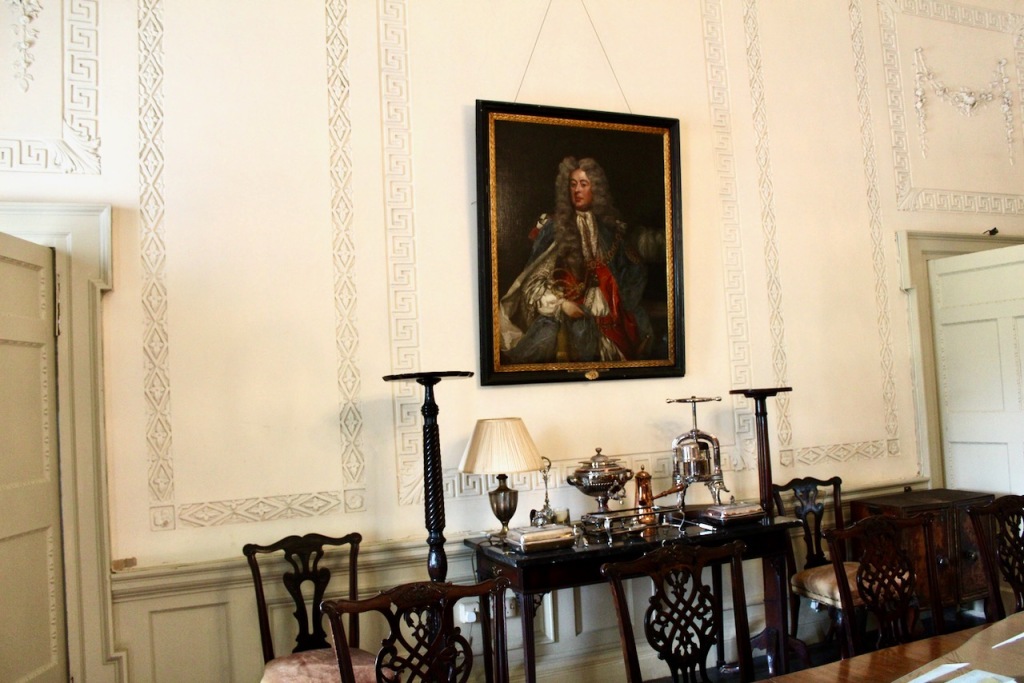
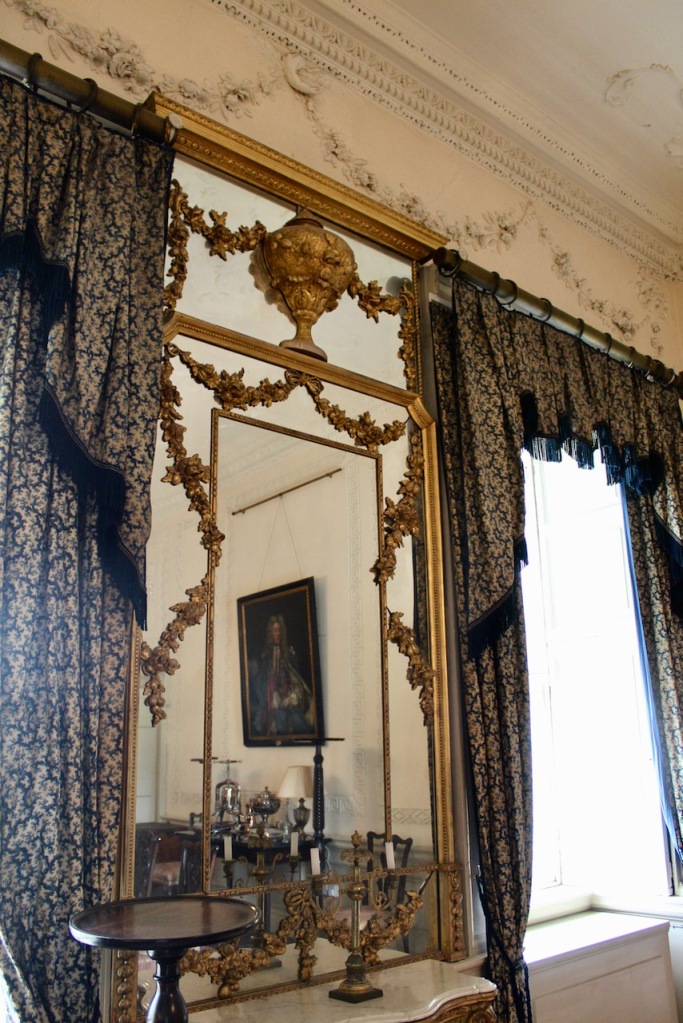
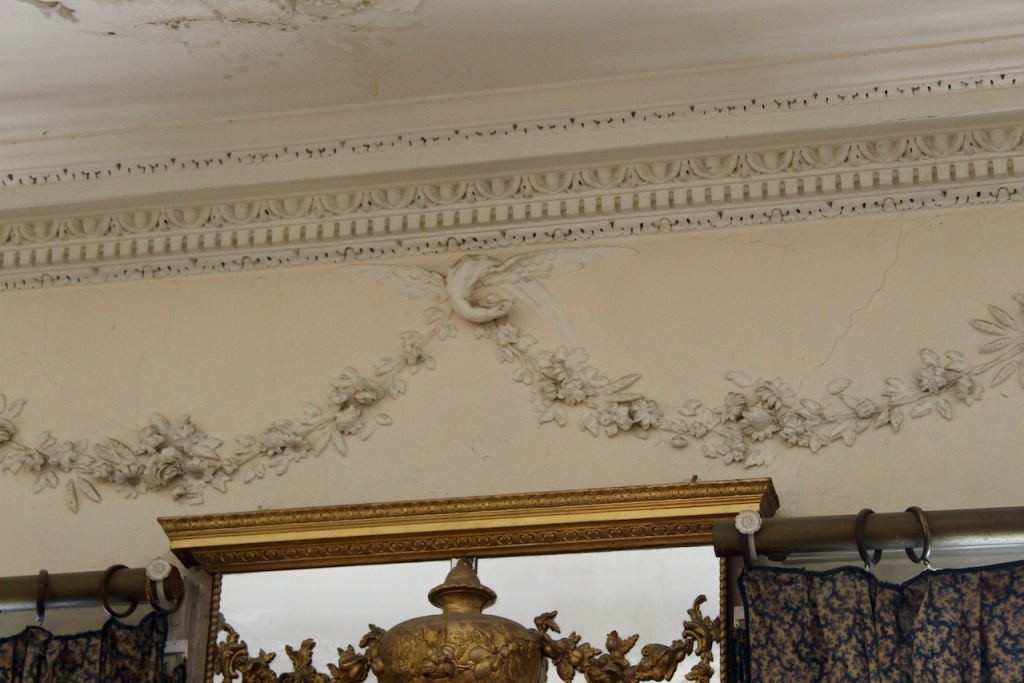

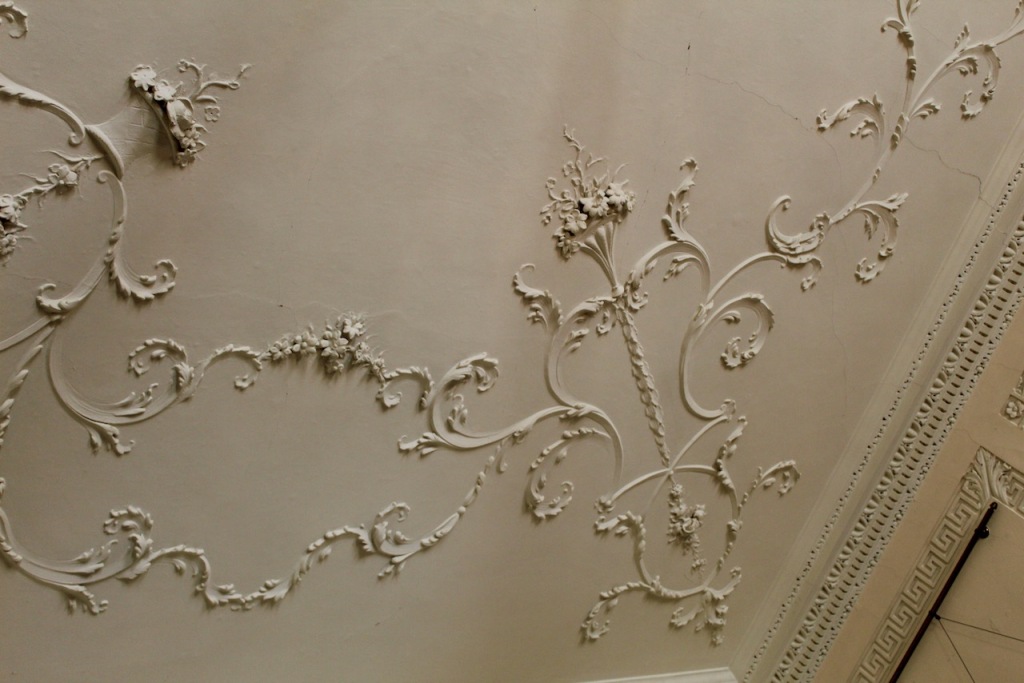

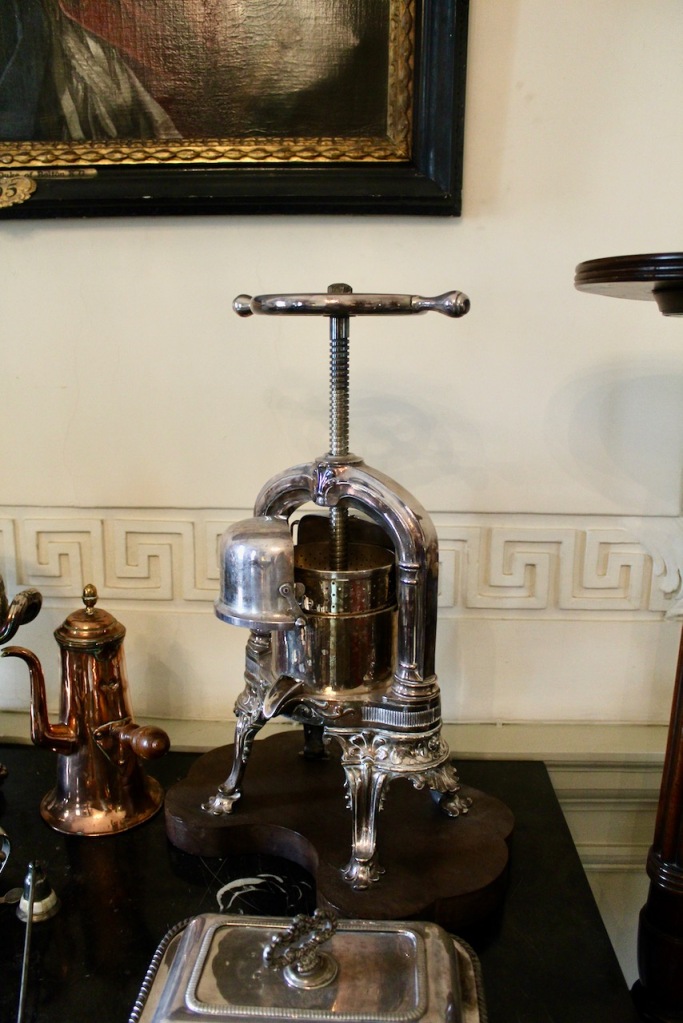
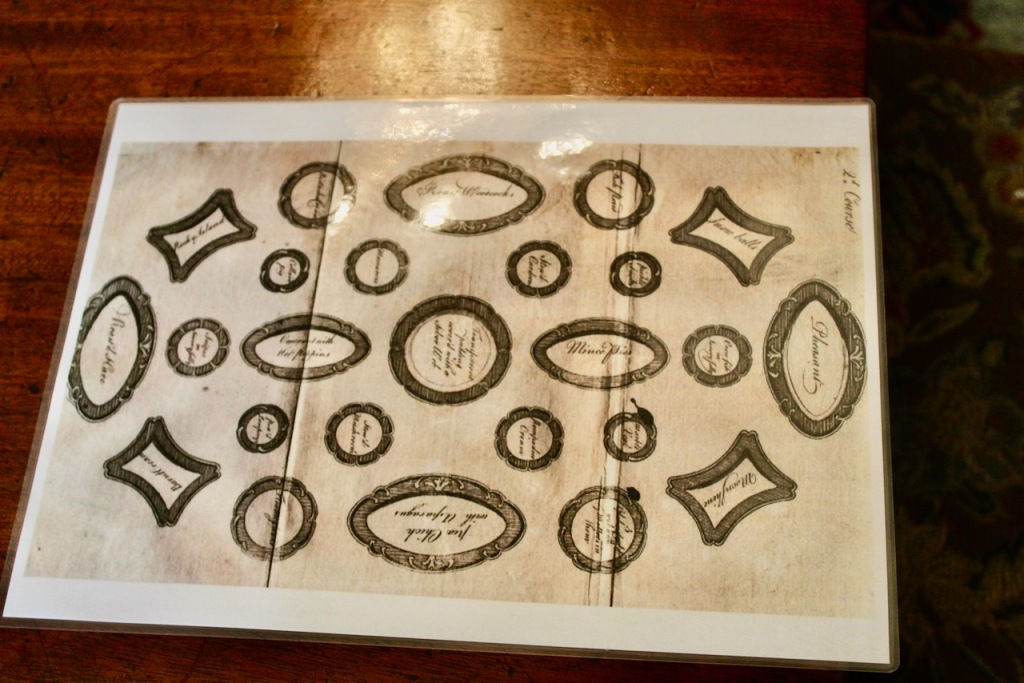
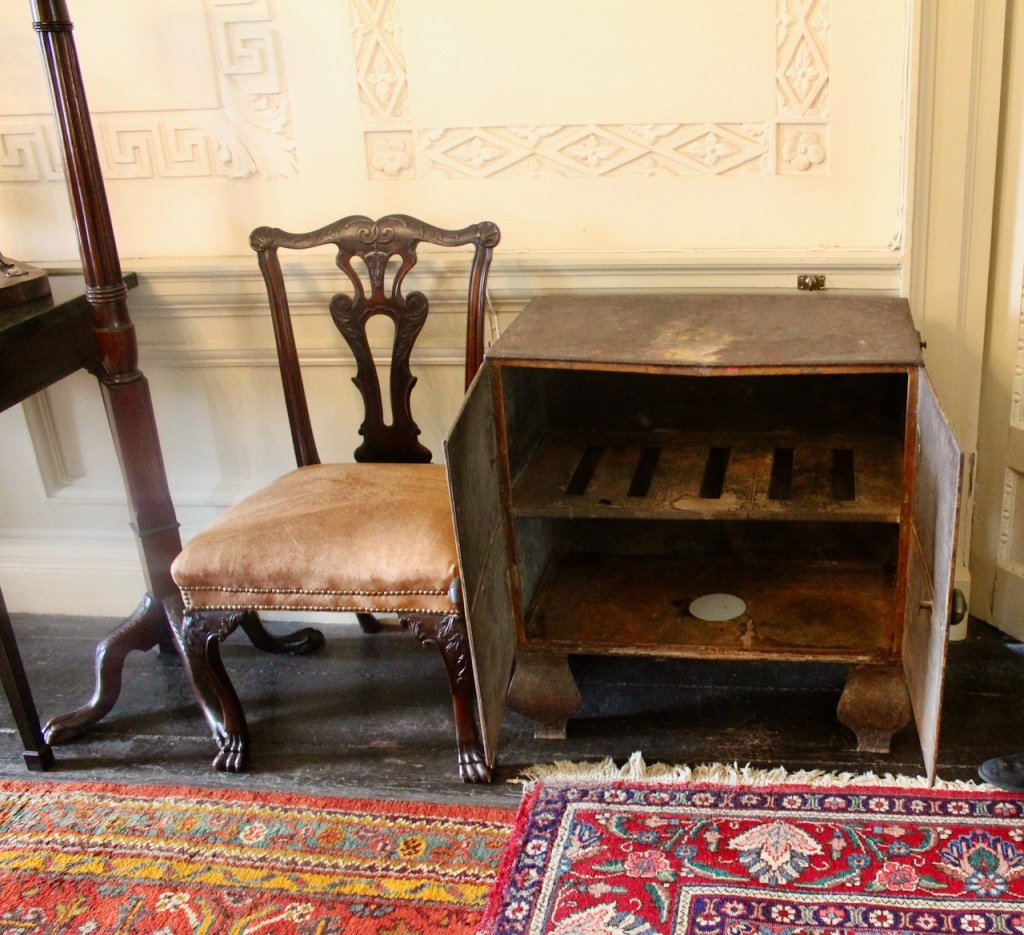

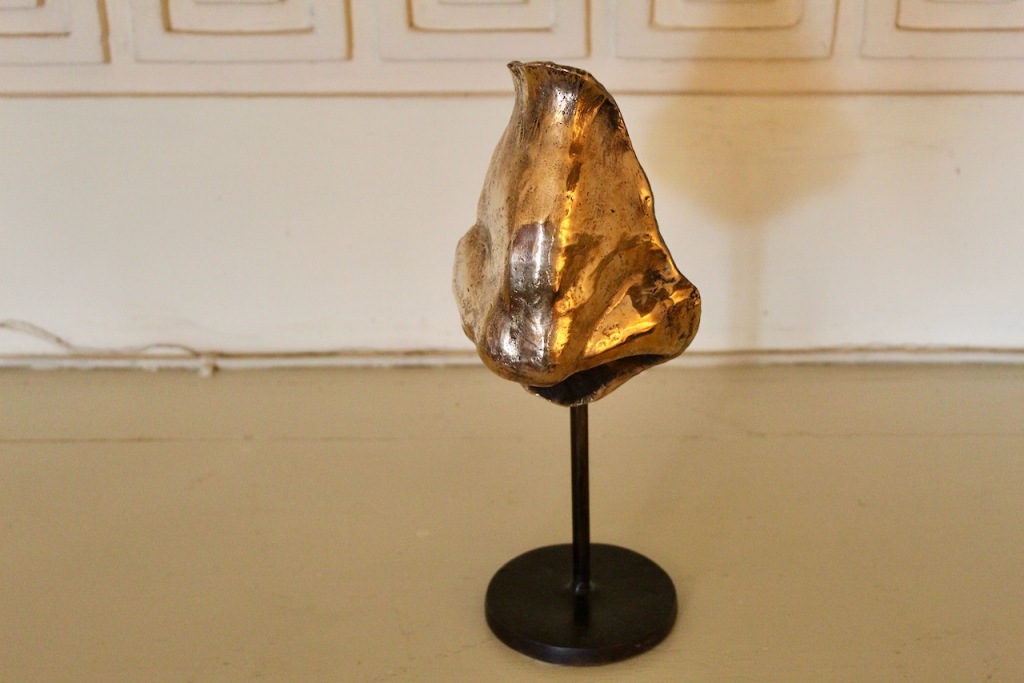
The library has a bow window and nicely fanned floorboards that were added in 1870.
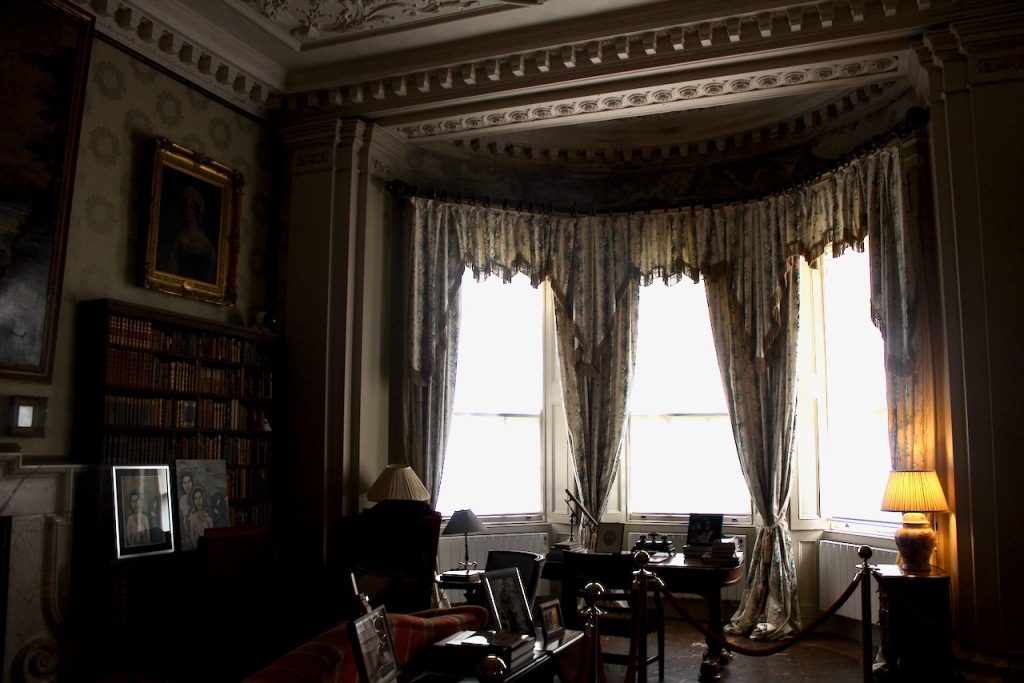
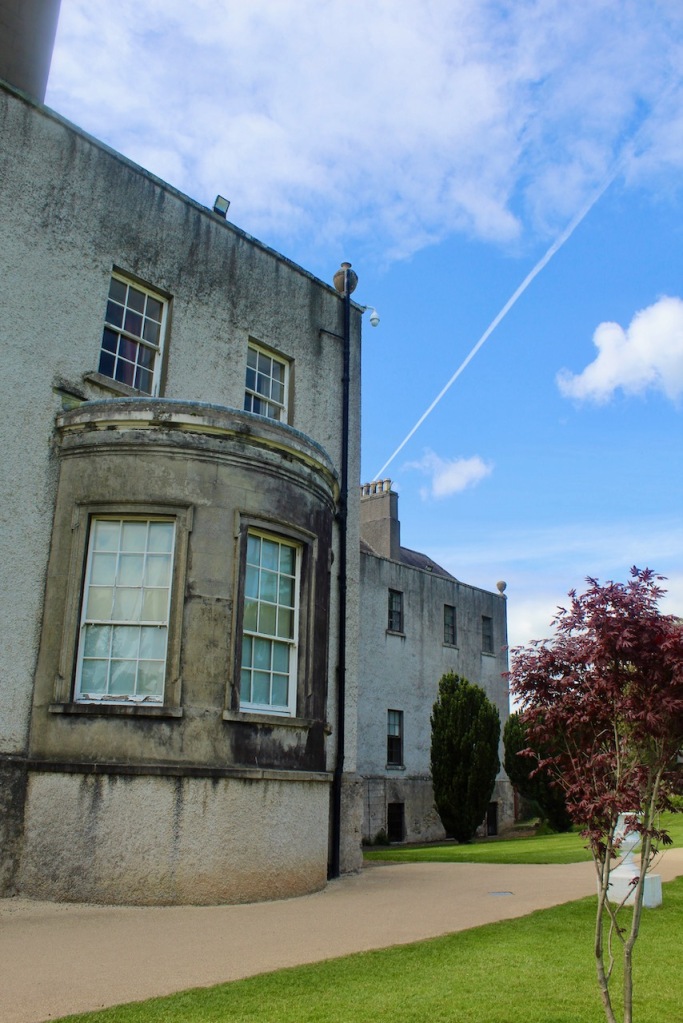
The style of original plasterwork is baroque in style. The ceiling of the library depicts the four seasons in each corner, with Greek and Roman gods.
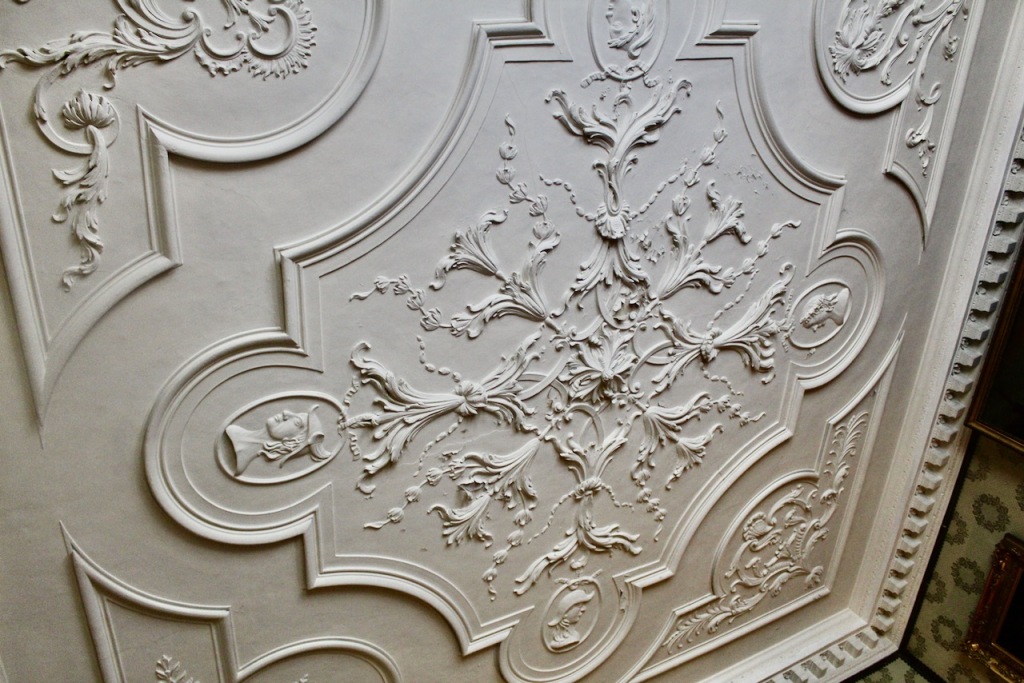
Hugh Montgomery-Massingberd and Christopher Simon Sykes tell us that this room was last decorated several years ago when Alec Cobbe had curtains and wallpaper made. In one corner stands an unusual piece of furniture that may have been an oyster table. The estuary at Malahide was well known for oysters up until the mid 19th century and this table allows diners to deposit shells through a narrow channel.
Thomas Cobbe and his wife Elizabeth née Beresford had a son, Charles (1756-1798). He married Anne Power Trench of Garbally, County Galway in 1778 but also ran up considerable debts. As a result, his father Thomas had to sell some estates in Louth and their large townhouse in Palace Row. Charles served as MP for Swords in the Irish Parliament, and predeceased his father.
The website tells us that in 1810, Thomas gifted Newbridge to his eldest grandson, Charles Cobbe (1781-1857), who, as well as raising his own five children here, provided a centre of home life for the numerous children of his brothers.
Montgomery-Massingberd and Sykes tell us that two interesting portraits hang in the library: Charles Cobbe and Fanny Kemble. Charles, great grandson of the Archbishop, went to India with his brother to join the Duke of Wellington’s forces. When he moved back, his grandparents Tommy and Lady Betty Cobbe had gone to live in Bath and the house had been closed up. Following marriage to Frances Conway he began restoring Newbridge to its former glory from 1810 onwards. Much of the furnishings date from this golden period in the house’s history. The actress Fanny Kemble was a friend of Fanny Cobbe and a frequent visitor to the house. [5]

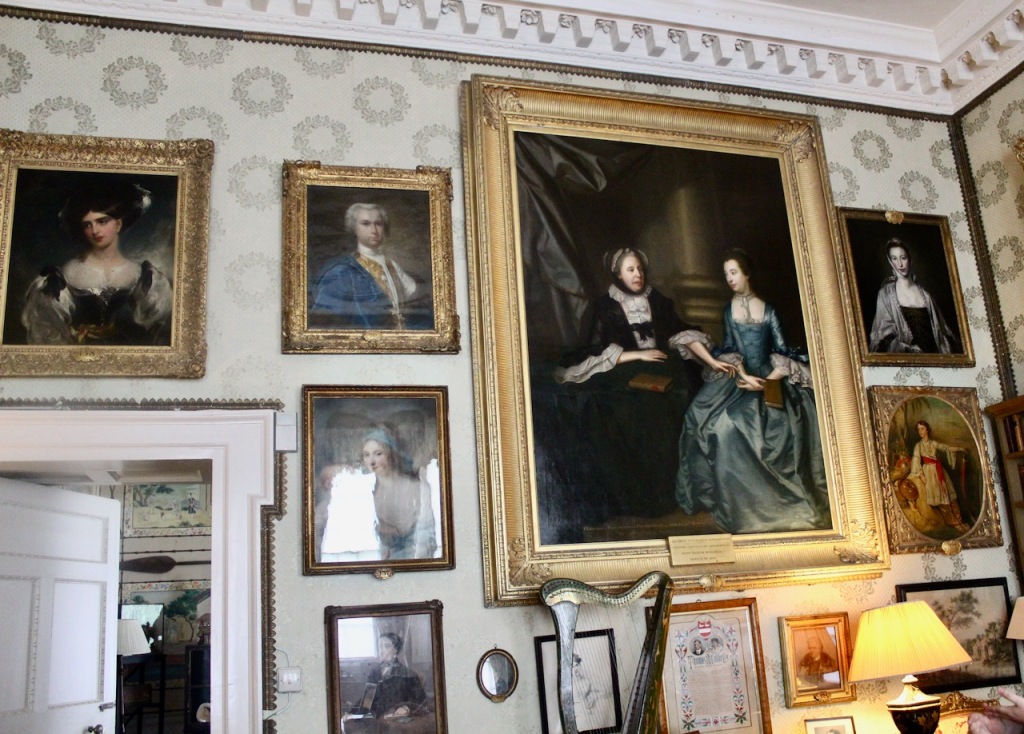
One room is dedicated as a “cabinet of curiosities.” Desmond Guinness and Desmond FitzGerald tell us in their entry about Newbridge House in Great Irish Houses that the collection may have started life as a shell collection in the 1790s by Elizabeth Beresford (1736-1860) who married the archbishop’s son Colonel Thomas Cobbe. She came from Curraghmore in County Waterford (see my entry on Curraghmore) and would have been familiar with her mother’s Shell Cottage. Much of what we see in the collection today comes from the Indian subcontinent, including a Taj Mahal in alabaster, ostrich eggs, corals, statues of house gods, a snake charmer’s box and tusks with carving noting the abolition of slavery [see 5]. The oriental theme is even carried through to the elephant design curtains. The panels on the wall are reproduction of the originals.
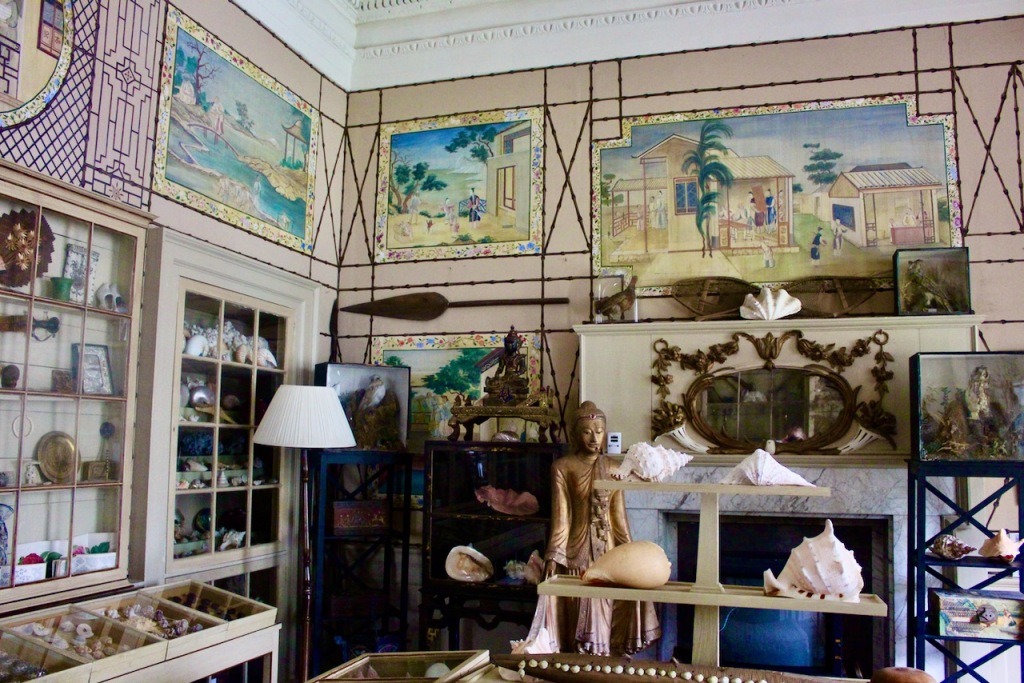


Mark Bence-Jones continues: “Soon after the Archbishop’s death, 1765, his son, Col Thomas Cobbe, MP, who had a fashionable wife, a sister of 1st Marquess of Waterford, added a wing at the back of the house containing a very large drawing room, with a ceiling of rococo plasterwork by Robert West [we now know it is actually by a pupil of Robert West, Richard Williams], who also decorated the family pew in the Protestant church at Donabate. This great room, which is now hung with a scarlet wallpaper, is entered by way of a corridor and though a monumental doorway with a pediment and fluted engaged Corinthian column.”
The grand drawing room is entered via a sculpture gallery.


The Corinthian door, which was executed between 1763 and 1764, is a marvellous entrance to the room. Montgomery-Massingberd and Sykes tell us it was George Semple who oversaw the new building work. [see 3]. They write:
“Above all, Thomas, who followed his maternal grandfather, Speaker Sir Richard Levinge, 1st Baronet, into the Irish House of Commons, and Lady Betty, a celebrated hostess, were determined to make Newbridge a fashionable place for entertaining. They promptly extended the house by adding the Red Drawing Room, a highly impressive chamber, 45 feet long, entered through a monumental doorway with a pediment and fluted engaged Corinthian columns. The glorious ceiling of rococo plasterwork, and also the one which enlivened the Archbishop’s Dining Room, is by the Dublin stuccodore Richard Williams, a pupil of Robert West of Florence Court fame.“
The ornate ceiling in this room includes baskets of flowers and exotic bird dragons. An article in the 2017 Irish Georgian Society Review tells us that Williams worked so much in the house that he married the children’s nurse!
The room was last redecorated in 1828, when the wallpaper, curtains and the unusual curtain rails were commissioned. The Dublin upholsterers Mack, Williams and Gibton supplied the carpet and curtains. The fireplace is Italian.
Archbishop Charles Cobbe and his son Thomas were assisted in the purchase of art by Matthew Pilkington, husband of the writer Letitia Pilkington, a friend of Jonathan Swift.
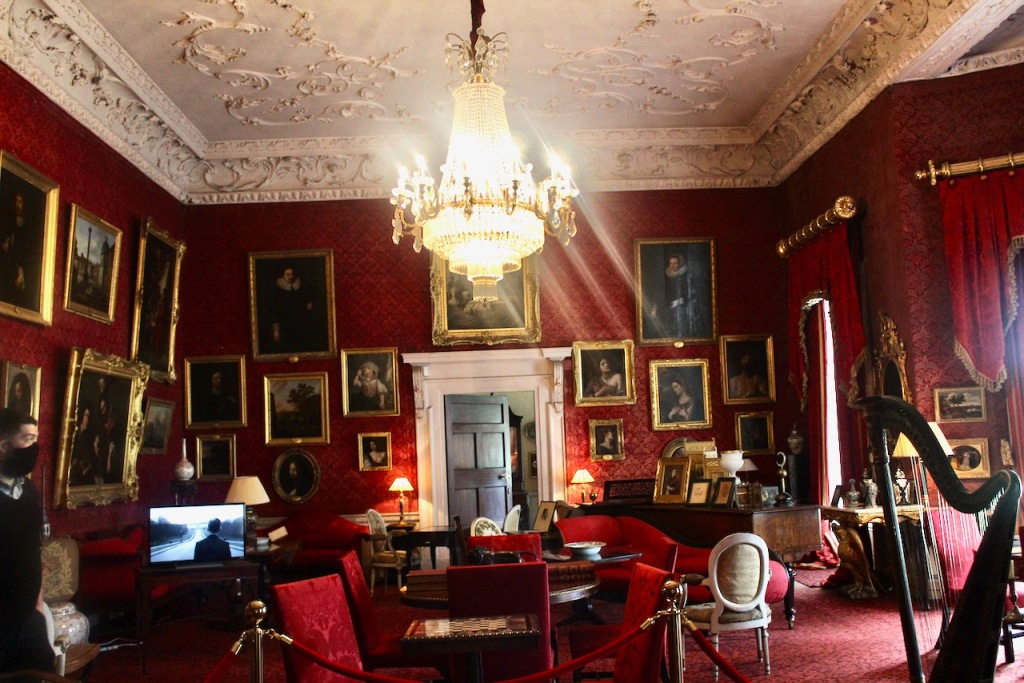

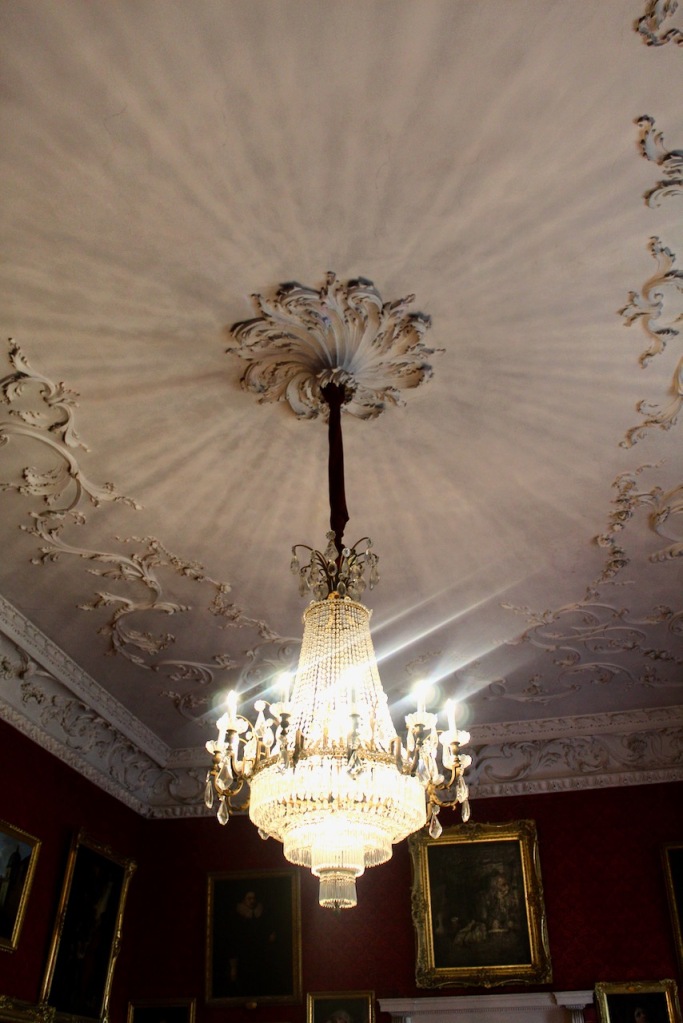




Hugh Montgomery-Massingberd and Christopher Simon Sykes tell us:
“Besides serving as Thomas and Lady Betty’s salon, the Red Drawing Room was also in effect a picture gallery to show off the magnificent collection of Old Master paintings which they formed with the expert advice of the local clergyman the Reverend Matthew Pilkington. For as well as being Vicar of Donabate (where the Cobbe family piew was also decorated by ‘Williams the Stoccoer,’ as he is described in the Newbridge accounts), Pilkington was, by a happy chance, the author of The Gentleman’s and Connoisseur’s Dictionary of Painters (1770), the first such work of reference to be published in English.” [see 2, p. 130]
Robert O’Byrne tells us more about the Reverend Matthew Pilkington:
“In 1725 he married the well-connected Laetitia van Lewen, as diminutive – but also as witty – as her husband, and the couple became friends with the likes of Jonathan Swift and Patrick Delany. Through the former Pilkington secured the position of Chaplain to the London Mayor of London and so moved to the other side of the Irish Sea. However in London he antagonized potential supporters and was imprisoned two years later. On returning to Dublin, he then became estranged from his wife and the couple was eventually and scandalously divorced in 1737: just over a decade later Laetitia Pilkington published her entertaining memoirs, from which her former husband emerges in a poor light. Ultimately he recovered his social position thanks to the patronage of Charles Cobbe, Archbishop of Dublin who offered Pilkington the living of Donabate and Portraine next to Cobbe’s newly completed seat at Newbridge.” [6]

The website tells us of Charles Cobbe (1781-1857) and his family. Cobbe was concerned with the welfare and the living conditions of his tenants, and in the 1830s he sold two of the best pictures of this room to raze the ‘wretched mud cabins’ of his tenants and replace them with proper cottages.
Charles’s daughter, Frances Power Cobbe, would become a noted philanthropist, feminist and writer, and advocated university education for women. She was the author of a number of books and essays, including The Intuitive Theory of Morals (1855), On the Pursuits of Women (1863), Cities of the Past (1864), Criminals, Idiots, Women and Minors (1869), Darwinism in Morals (1871) and Scientific Spirit of the Age (1888). She was the partner of Mary Lloyd, the sculptor, whom she met in Rome. In letters and published writing, Cobbe referred to Lloyd alternately as “husband,” “wife,” and “dear friend.”
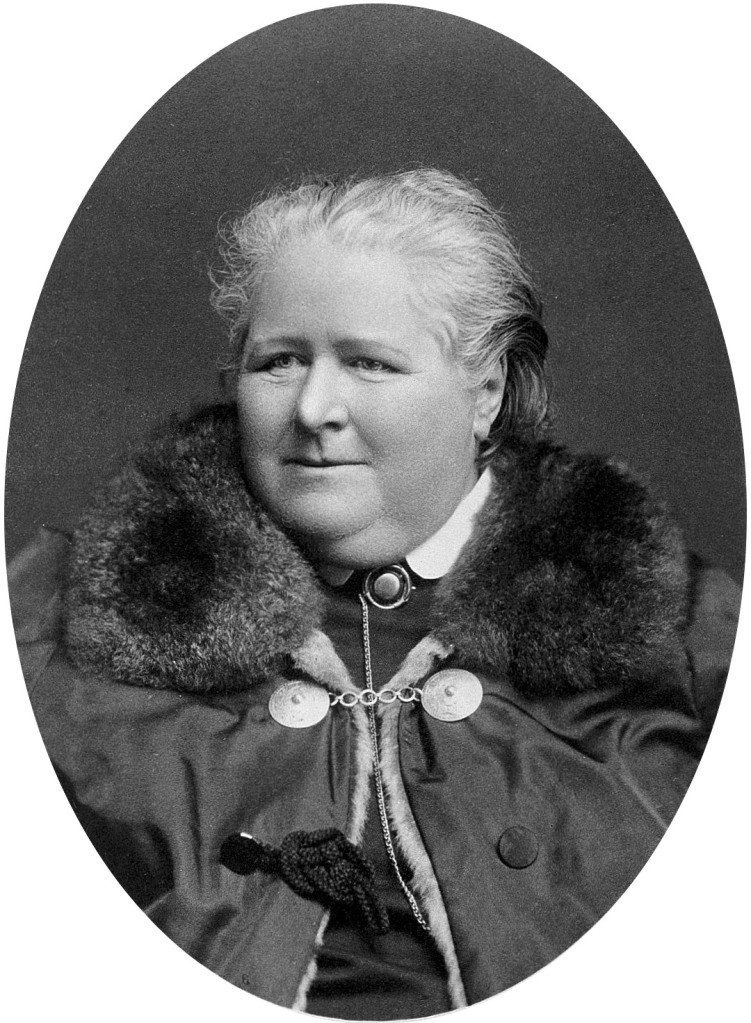
Charles occupied Newbridge for 47 years and on his death it passed to his son, also named Charles (1811-1886). The house passed from Charles (1811-1886) to his brother Thomas’s son, Leuric Charles Cobbe (1859-97), and then to his son, Thomas Maberley Cobbe (1884-1914). The website continues:
“…Thomas Maberley Cobbe married Eleanor Colville Frankland, the elegant daughter of an Anglo-American heiress and descendant of one of the Founding Fathers of the United States, John Jay. The couple, setting up at Newbridge at the beginning of the 20th century, entertained guests, raised their family and managed the estate for the trustees. In 1933, Newbridge was inherited by their son Tommy, who was born and lived there his whole life. When he died in 1984 it passed to his two nephews and his niece who had grown up in the house.“
The nephews and niece were children of Tommy’s brother Francis (1913-1949): Hugh, Alec and Mary – their mother was also a Cobbe (descended from the fourth son of Charles Cobbe and Anne Power Trench).
The house tour includes the basement and servants’ quarters.
Hugh Montgomery-Massingberd and Christopher Simon Sykes write:
p. 131. “Nostalgically stocked kitchens, laundries and outbuildings help present a rounded picture of life in an Irish country house. The coaches on display in the stables include a splendid State Coach built in 1790 (about the same time as the square cobbled courtyard was laid out) for ‘Black Jack’ FitzGibbon, Lord Chancellor of Ireland.“
They tell us that ‘Black Jack’ was notorious for his remark that he would ‘tame the Irish like cats.’ Hardly surprisingly, they add, that his coffin had dead cats thrown at it.


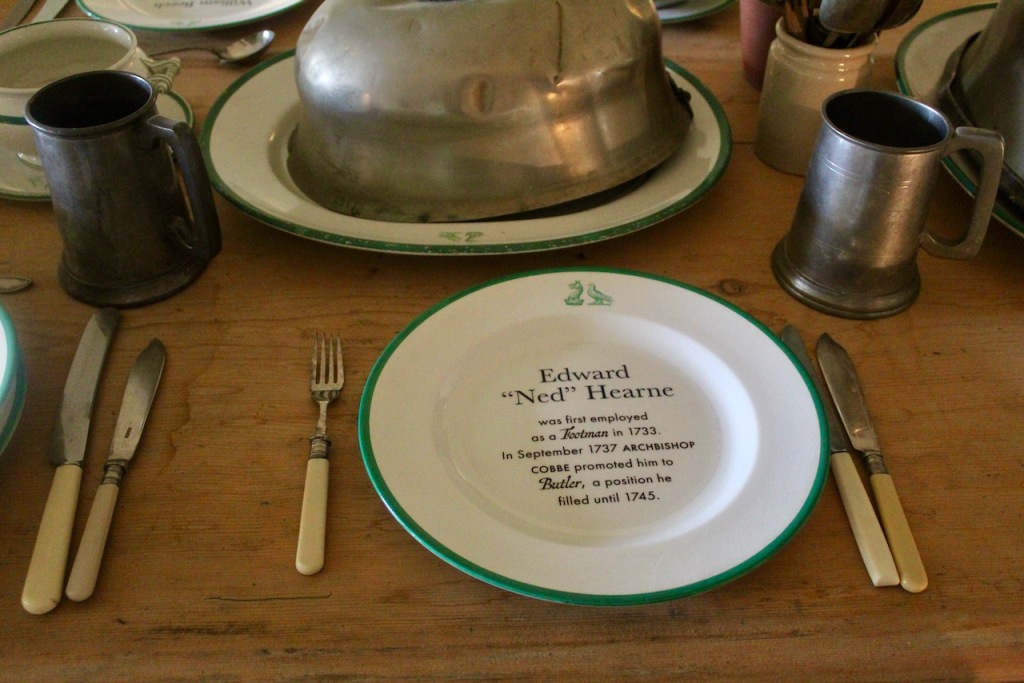

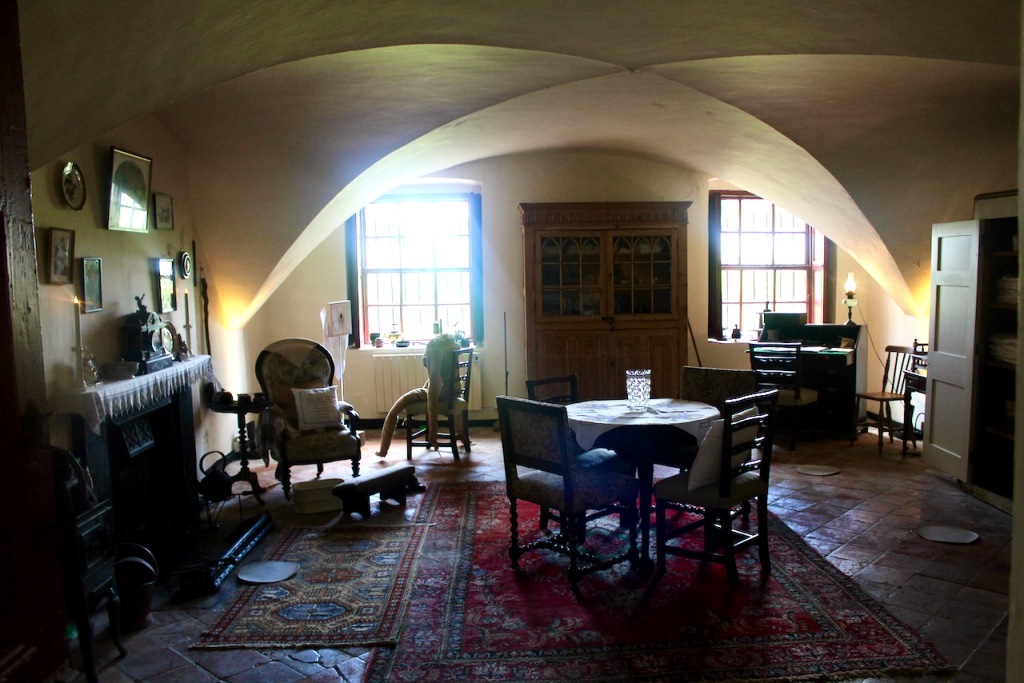


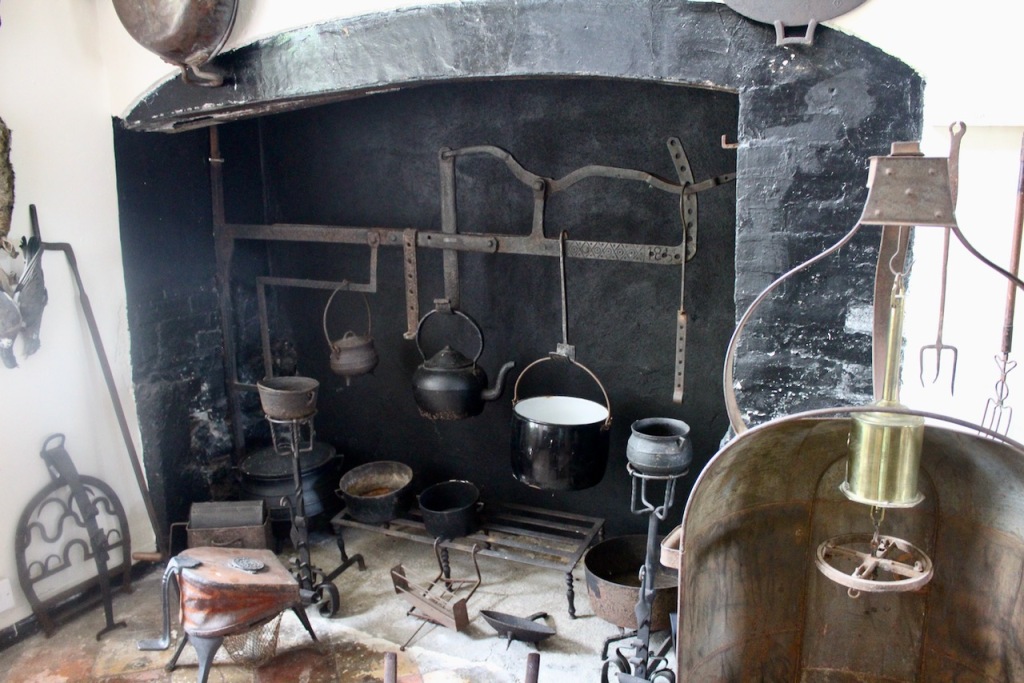

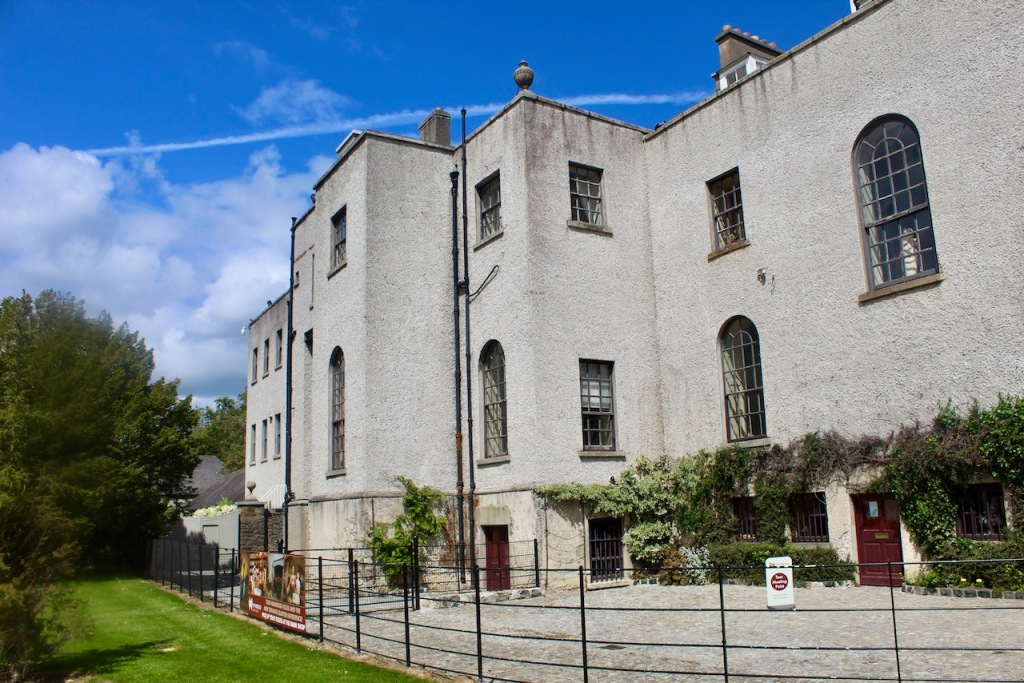
There is a farmyard with animals to visit and an old forge.

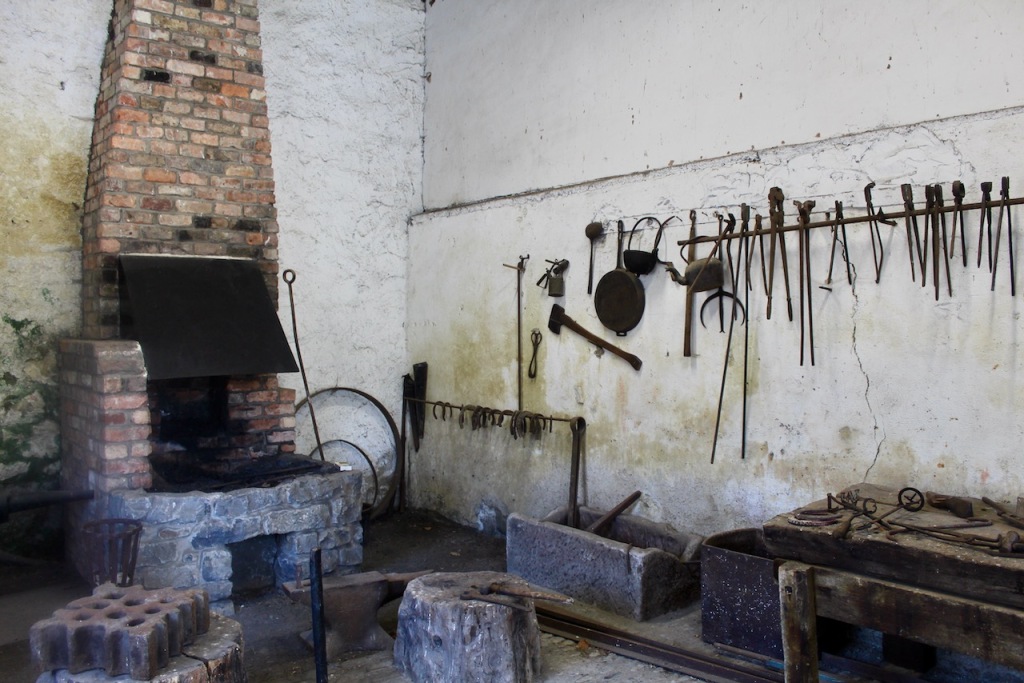
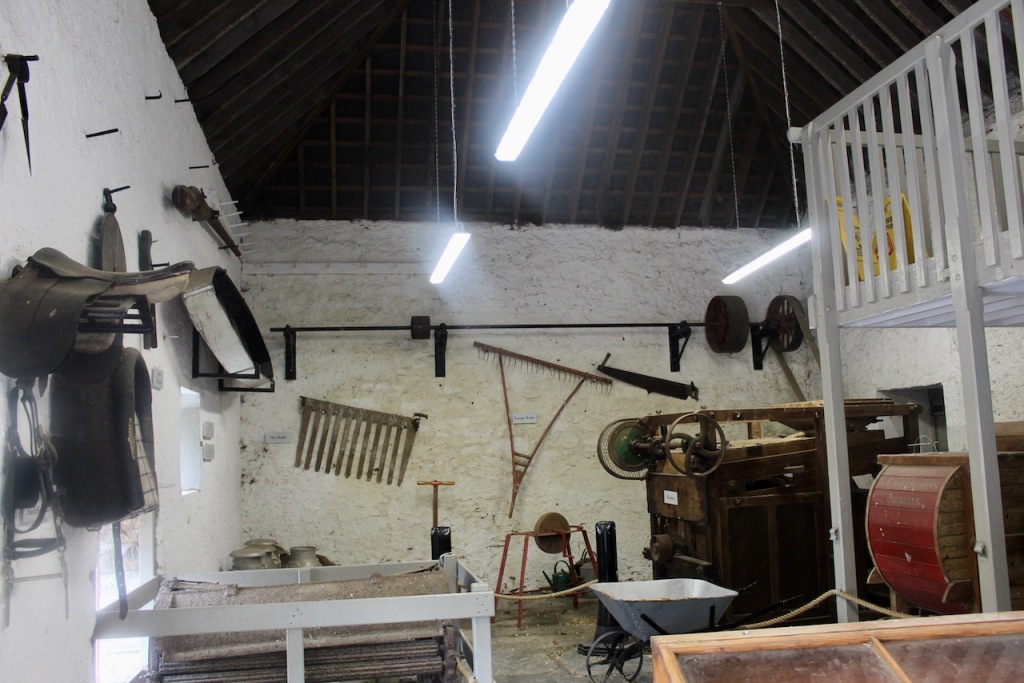
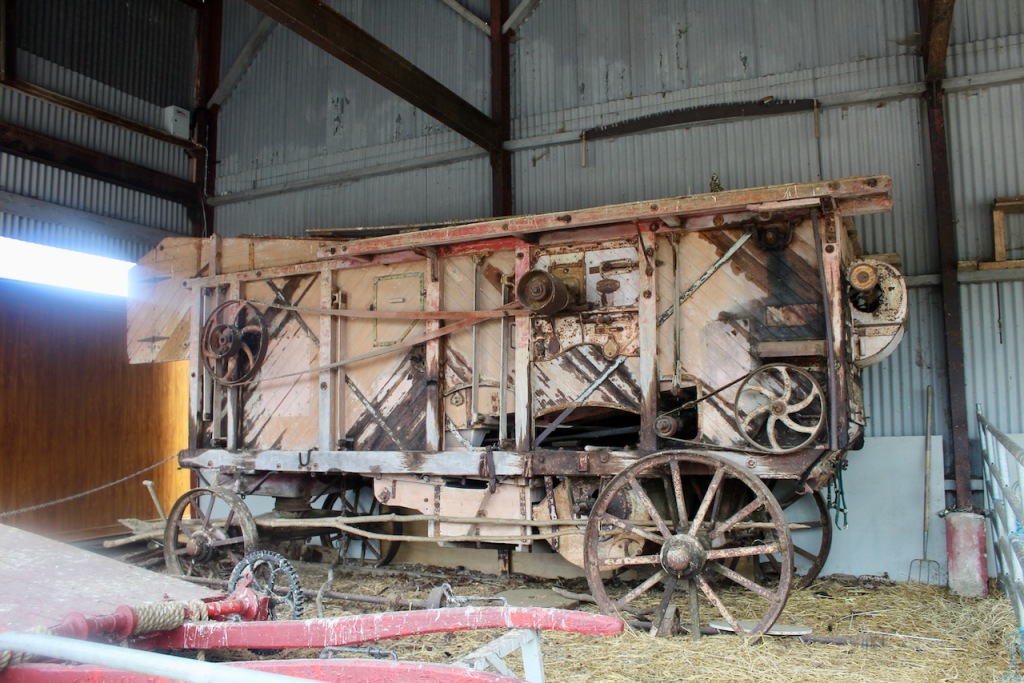
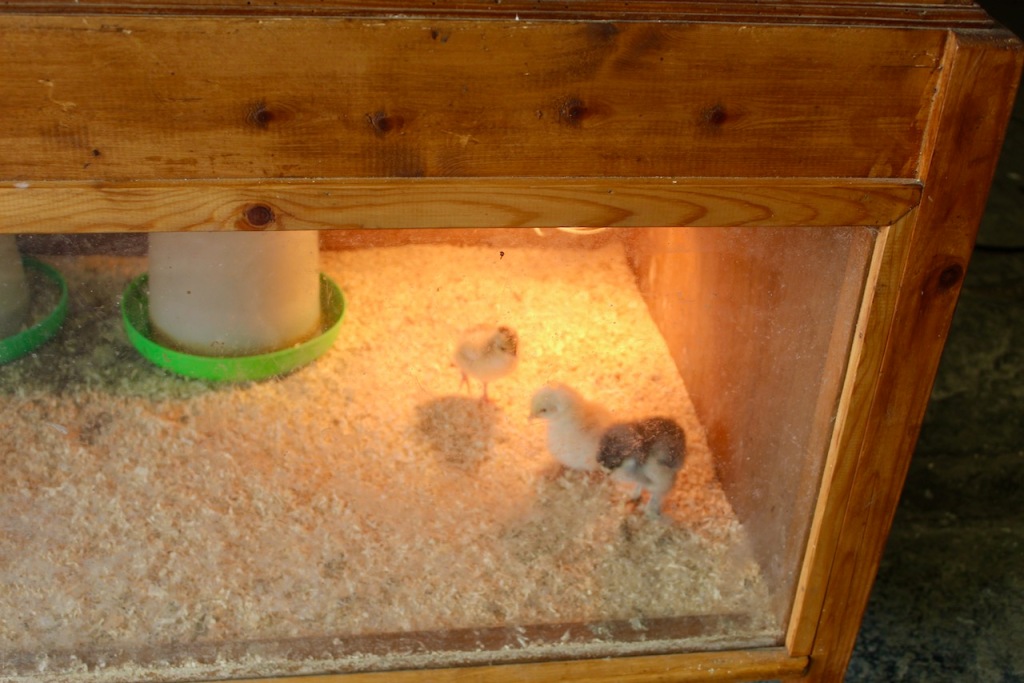
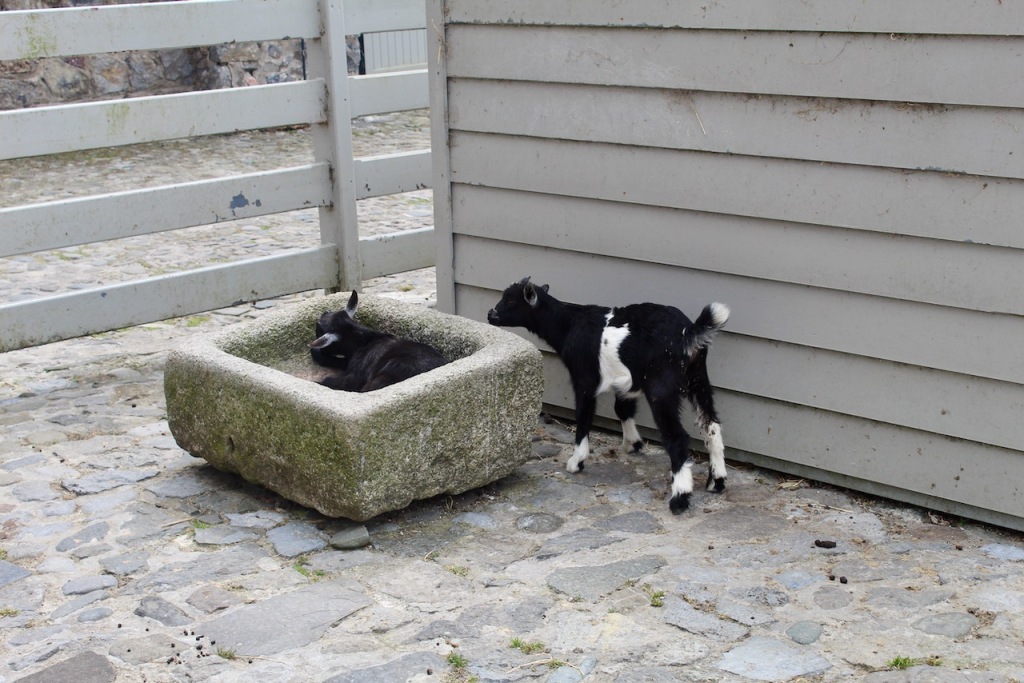
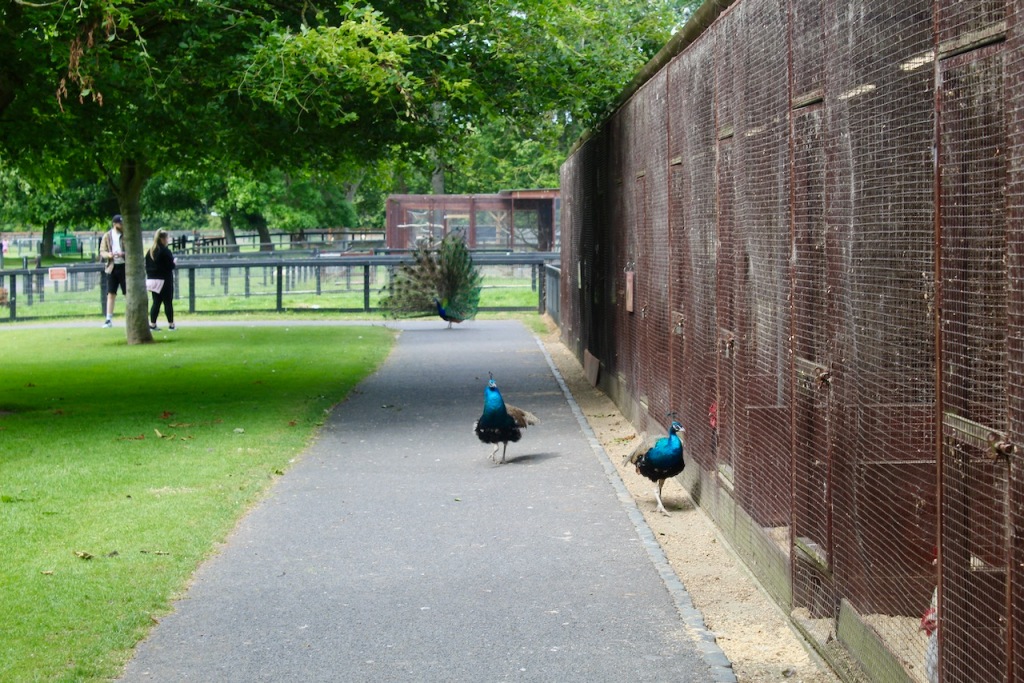
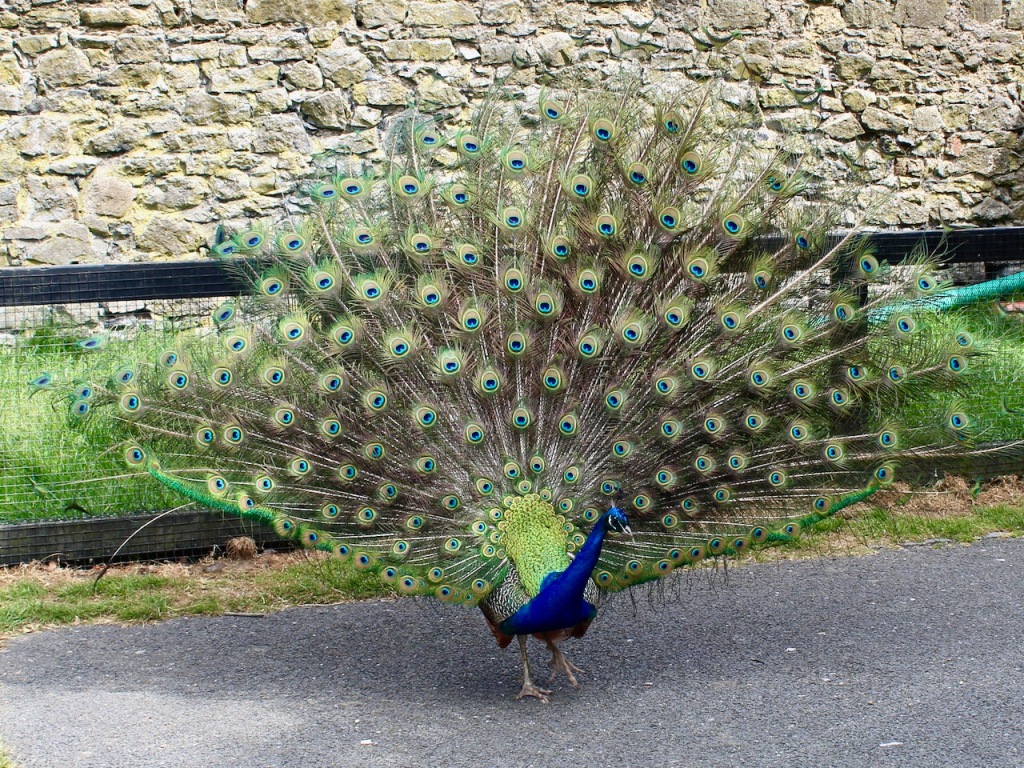


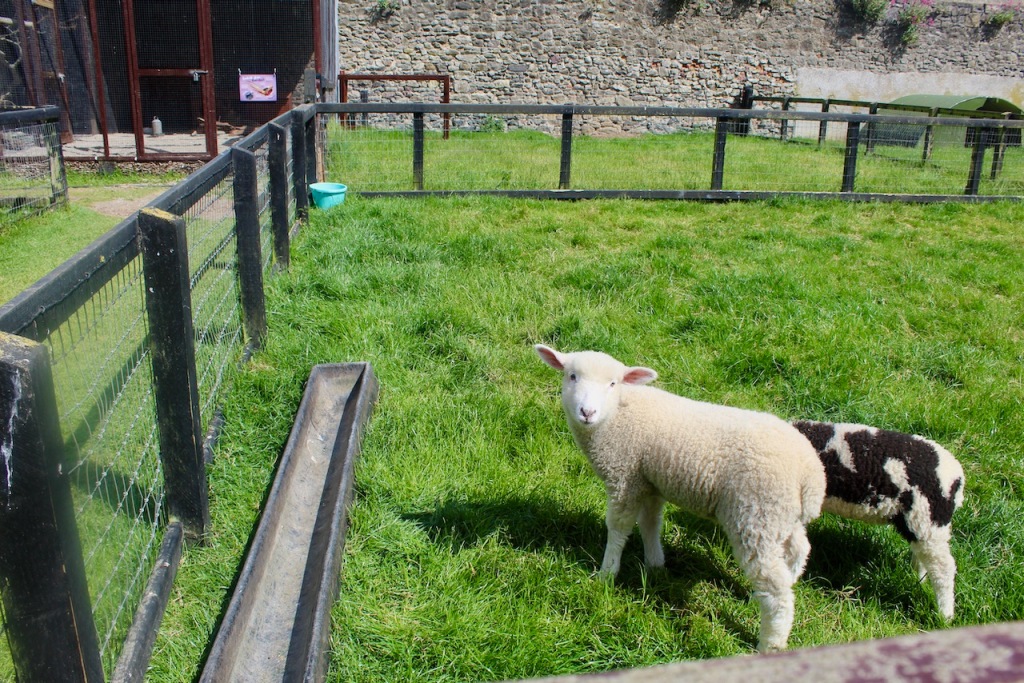
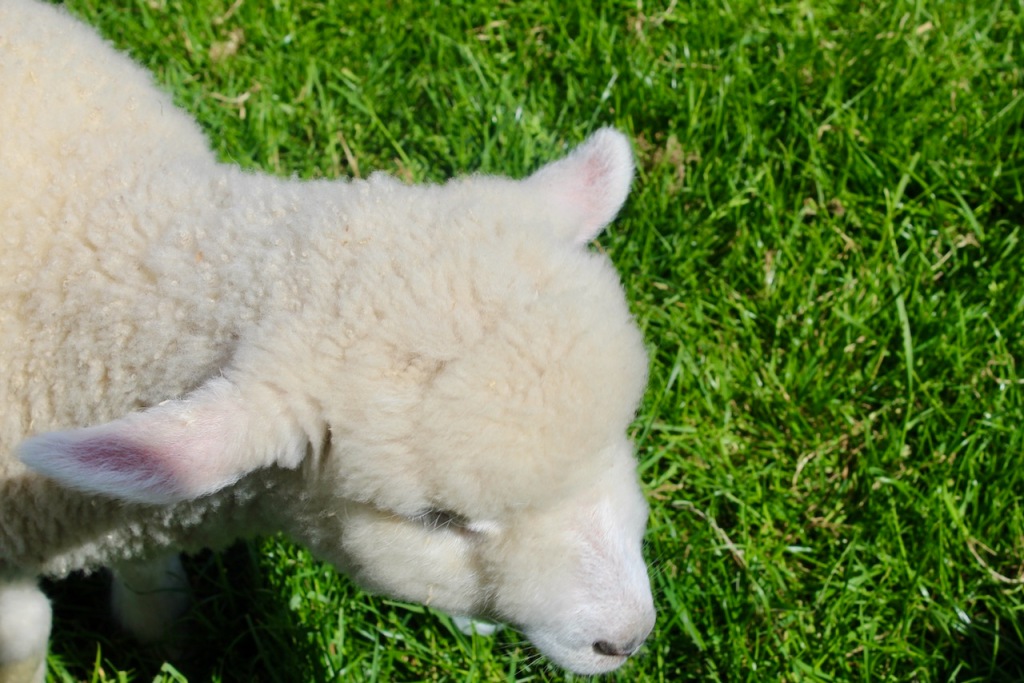
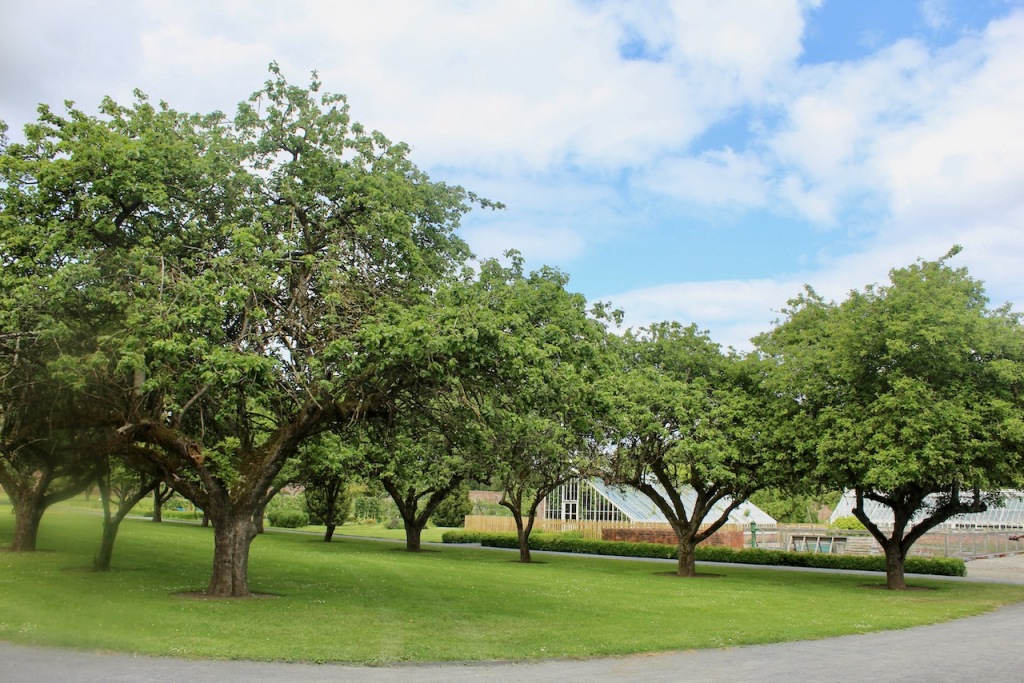
[1] p. 241, Great Irish Houses. Foreward by Desmond FitzGerald and Desmond Guinness. IMAGE Publications, 2008.
[2] p. 131, Montgomery-Massingberd, Hugh and Christopher Simon Sykes. Great Houses of Ireland, Laurence King Publishing, London, 1999.
[3] p. 123, Montgomery-Massingberd, Hugh and Christopher Simon Sykes. Great Houses of Ireland, Laurence King Publishing, London, 1999.
[4] p. 242, Great Irish Houses. Foreward by Desmond FitgGerald and Desmond Guinness. IMAGE Publications, 2008.
[5] p. 245, Great Irish Houses. Foreward by Desmond FitgGerald and Desmond Guinness. IMAGE Publications, 2008.